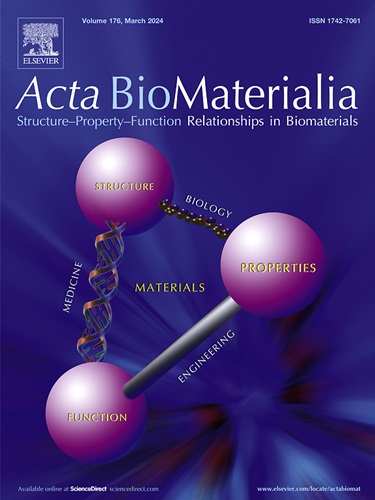Co-delivery of neurotrophic factors and a zinc chelator substantially increases retinal ganglion cell survival and axon protection in the optic nerve crush model
IF 9.6
1区 医学
Q1 ENGINEERING, BIOMEDICAL
引用次数: 0
Abstract
Traumatic optic neuropathies lead to retinal ganglion cell (RGC) death and axonal degeneration, primarily due to disrupted neurotrophic factor (NTF) supply from the brain and a neurotoxic cascade, potentially mediated by elevated retinal Zn²⁺ levels. Ciliary neurotrophic factor (CNTF) and brain-derived neurotrophic factor (BDNF) are two major NTFs known to support RGC survival and axon protection. Dipicolylamine (DPA), a Zn²⁺ chelator with high selectivity and affinity, offers a strategy to reduce excess Zn²⁺. To achieve sustained NTF delivery and Zn²⁺ reduction, we developed sulfonated poly(serinol hexamethylene urea) nanoparticles (S-PSHU NPs) co-loaded with CNTF, BDNF, and DPA. In vitro release studies demonstrated sustained release of CNTF and BDNF for up to 8 weeks and DPA for up to 4 weeks. In a rat optic nerve crush (ONC) model, DPA-loaded S-PSHU NPs showed dose-dependent elimination of retinal Zn²⁺. Additionally, in primary RGC culture, RGC activity and axon growth correlated with CNTF and BDNF dosage. In vivo, NTF-DPA-loaded S-PSHU NPs significantly enhanced RGC survival and axon protection post-ONC, as evidenced by cholera toxin subunit B (CTB)-labeled axons in the central visual centers of the brain, including the suprachiasmatic nucleus, lateral geniculate nucleus, and superior colliculus.
Statement of significance
• Co-delivery of neurotrophic factors (NTFs: CNTF and BDNF) and a zinc chelator (dipicolylamine, DPA) promotes retinal ganglion cell (RGC) axon survival and protection.
• Sustained release of NTFs for up to 8 weeks and DPA for up to 4 weeks.
• DPA-loaded nanoparticles effectively eliminate excess retinal zinc after optic nerve injury.
• NTF-DPA-loaded nanoparticles significantly improve RGC survival and axon protection in a rat optic nerve crush model.

在视神经挤压模型中,神经营养因子和锌螯合剂的共同递送可显著增加视网膜神经节细胞存活和轴突保护。
外伤性视神经病变导致视网膜神经节细胞(RGC)死亡和轴突变性,主要是由于大脑神经营养因子(NTF)供应中断和神经毒性级联,可能由视网膜Zn 2 +水平升高介导。睫状神经营养因子(CNTF)和脑源性神经营养因子(BDNF)是已知支持RGC存活和轴突保护的两种主要ntf。二聚胺(DPA)是一种具有高选择性和亲和力的Zn 2 +螯合剂,提供了一种减少过量Zn 2 +的方法。为了实现持续的NTF传递和Zn 2 +还原,我们开发了磺化聚丝氨酸醇六亚甲基脲纳米颗粒(S-PSHU NPs),共载CNTF、BDNF和DPA。体外释放研究表明,CNTF和BDNF的持续释放长达8周,DPA的持续释放长达4周。在大鼠视神经挤压(ONC)模型中,dpa负载的S-PSHU NPs显示出剂量依赖性,可以消除视网膜Zn 2 +。此外,在原代RGC培养中,RGC活性和轴突生长与CNTF和BDNF剂量相关。在体内,ntf - dpa负载的S-PSHU NPs显著提高了onc后RGC存活和轴突保护,这一点得到了霍乱毒素亚单位B (CTB)标记的大脑中央视觉中心轴突的证明,包括视交叉上核、外侧胫状核和上丘。意义声明:•神经营养因子(NTFs: CNTF和BDNF)和锌螯合剂(二聚胺,DPA)共同递送可促进视网膜神经节细胞(RGC)轴突的存活和保护。•持续释放ntf长达8周,DPA长达4周。•dpa负载纳米颗粒有效消除视神经损伤后视网膜锌过量。•在大鼠视神经挤压模型中,ntf - dpa负载纳米颗粒显著改善RGC存活和轴突保护。
本文章由计算机程序翻译,如有差异,请以英文原文为准。
求助全文
约1分钟内获得全文
求助全文
来源期刊

Acta Biomaterialia
工程技术-材料科学:生物材料
CiteScore
16.80
自引率
3.10%
发文量
776
审稿时长
30 days
期刊介绍:
Acta Biomaterialia is a monthly peer-reviewed scientific journal published by Elsevier. The journal was established in January 2005. The editor-in-chief is W.R. Wagner (University of Pittsburgh). The journal covers research in biomaterials science, including the interrelationship of biomaterial structure and function from macroscale to nanoscale. Topical coverage includes biomedical and biocompatible materials.
 求助内容:
求助内容: 应助结果提醒方式:
应助结果提醒方式:


